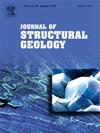40Ar/39Ar dating of poly-orogenic rocks: an example from the Cap de Creus peninsula (Eastern Pyrenees, Spain)
IF 2.9
2区 地球科学
Q2 GEOSCIENCES, MULTIDISCIPLINARY
引用次数: 0
Abstract
A new 40Ar/39Ar study has been conducted on variably deformed rocks from the Cap de Creus massif in the Eastern Pyrenees with a focus on NW-SE crosscutting low-grade shear zones. Outside the shear zones, in the unsheared low pressure - high temperature Variscan metamorphic rocks (P∼3,5 kbar, T∼635 °C), mica porphyroblasts yield partially reset 40Ar/39Ar ages of 240 Ma to 150 Ma. In shear zones (P∼5-5,3 kbar, T∼435–505 °C) from the Northern Shear Belt, synkinematic fine-grained muscovite provides a crystallization age of 44-42 Ma while inherited clastic muscovite has ages between 175 and 100 Ma depending on grain size. In the Southern Shear Belt, magmatic biotite from granodioritic protomylonites preserves small amount of inherited argon while synkinematic newly crystallized metamorphic micas from mylonites and ultramylonites have crystallization ages between 44 and 38 Ma. Therefore, this step-heating and in situ laser probe 40Ar/39Ar study of micas from unsheared Variscan rocks and mylonitic to ultramylonitic rocks show a conspicuous relationship between the deformation gradient, the amount of syntectonic (re)crystallization, the change in mineral composition, the resetting of Variscan mica chronometers and the record of Eocene crystallization ages by newly formed synkinematic micas. It is suggested that low-grade shear zones in the poly-orogenic Cap de Creus massif were active during the main period of Eocene convergence of the Iberian and European plates and emplacement of the south-verging crustal nappes. We propose that such NW-SE mylonitic structures developed as R′-Riedel faults within a huge system of NE-SW trending crustal faults and that they may represent onshore precursors of offshore transfer faults related to the early opening of the Gulf of Lion.
多造山岩的40Ar/39Ar定年:以西班牙东比利牛斯山的Creus半岛为例
在东比利牛斯山脉的Cap de Creus地块进行了一项新的40Ar/39Ar变形岩石研究,重点研究了NW-SE横切低品位剪切带。在剪切带外,在未剪切的低压-高温Variscan变质岩(P ~ 3,5 kbar, T ~ 635°C)中,云母斑岩产生部分重置的40Ar/39Ar年龄,为240 ~ 150 Ma。在北剪切带的剪切带(P ~ 5-5,3 kbar, T ~ 435-505°C)中,同动细粒白云母的结晶年龄为44-42 Ma,而继承碎屑白云母的结晶年龄在175 - 100 Ma之间,具体取决于晶粒大小。在南剪切带,花岗闪长原长玄武岩的岩浆黑云母保留了少量的继承氩,而与之同步的糜棱岩和超长玄武岩的新结晶变质云母的结晶年龄在44 ~ 38 Ma之间。因此,对未剪切的瓦里斯坎岩和糜伦岩到超长岩云母进行的步进加热和原位激光探测40Ar/39Ar研究表明,变形梯度、同构造(再)结晶量、矿物组成变化、瓦里斯坎云母时计重设与新形成的同运动云母记录始新世结晶年龄之间存在明显的关系。研究表明,在伊比利亚和欧洲板块辐合及南向地壳推覆构造侵位的始新世主要时期,克雷斯帽地块内的低等级剪切带处于活跃状态。我们认为这种北西-东向糜棱岩构造在一个巨大的NE-SW向地壳断裂体系中发育为R ' -Riedel断裂,它们可能是与狮子湾早期开放有关的海上转移断裂的陆上前兆。
本文章由计算机程序翻译,如有差异,请以英文原文为准。
求助全文
约1分钟内获得全文
求助全文
来源期刊

Journal of Structural Geology
地学-地球科学综合
CiteScore
6.00
自引率
19.40%
发文量
192
审稿时长
15.7 weeks
期刊介绍:
The Journal of Structural Geology publishes process-oriented investigations about structural geology using appropriate combinations of analog and digital field data, seismic reflection data, satellite-derived data, geometric analysis, kinematic analysis, laboratory experiments, computer visualizations, and analogue or numerical modelling on all scales. Contributions are encouraged to draw perspectives from rheology, rock mechanics, geophysics,metamorphism, sedimentology, petroleum geology, economic geology, geodynamics, planetary geology, tectonics and neotectonics to provide a more powerful understanding of deformation processes and systems. Given the visual nature of the discipline, supplementary materials that portray the data and analysis in 3-D or quasi 3-D manners, including the use of videos, and/or graphical abstracts can significantly strengthen the impact of contributions.
 求助内容:
求助内容: 应助结果提醒方式:
应助结果提醒方式:


